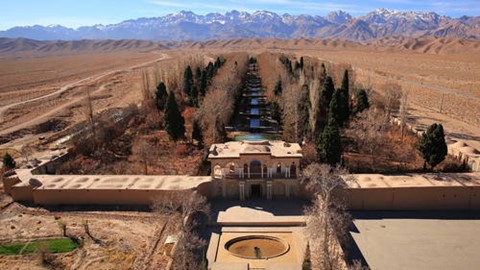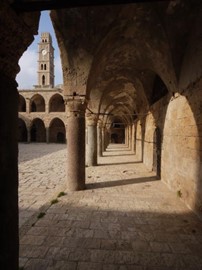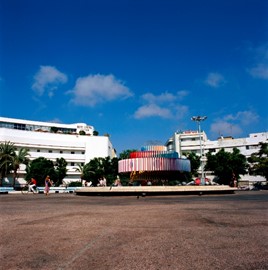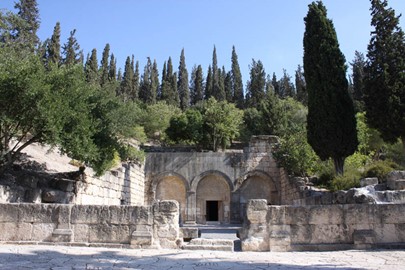category :: cultural
Masjed e Jamé
The Masjed-e Jāmé of Isfahan, a UNESCO World Heritage site in Iran, is an architectural masterpiece showcasing the evolution of Persian mosque design. This grand congregational mosque features intricate tilework, soaring domes, and expansive courtyards, reflecting centuries of Islamic art and engineering from the 8th to the 17th centuries. Renowned for its historical and cultural value, it stands as a testament to the ingenuity and aesthetic brilliance of its builders.
Gonbad e Qabus
Gonbad-e Qabus, a UNESCO World Heritage site in Iran, is an extraordinary 11th-century brick tower renowned for its architectural brilliance and historical significance. This 53-meter-tall mausoleum, built for the Ziyarid ruler Qabus ibn Wushmgir, features a conical roof and intricate geometric design, exemplifying early Islamic engineering. Set against a striking natural backdrop, it stands as a testament to Persian cultural heritage and ingenuity.
Golestan Palace
Golestan Palace, a UNESCO World Heritage site in Iran, is a stunning royal complex showcasing Persian architectural brilliance and opulence. This historic site features ornate tilework, mirrored halls, and elegant gardens, reflecting the grandeur of the Qajar dynasty. Recognized for its cultural value, it blends traditional design with European influences, offering a glimpse into Iran’s royal heritage.
Susa
Susa, a UNESCO World Heritage site in Iran, is an ancient city renowned for its archaeological significance, spanning multiple civilizations from the Elamite to the Persian periods. It features remnants of grand palaces, a ziggurat, and intricate artifacts that highlight its role as a political and cultural hub. This site exemplifies thousands of years of urban development and historical continuity in a strategic desert region.
Shahr i Sokhta
Shahr-i Sokhta, a UNESCO World Heritage site in Iran, is an ancient Bronze Age city renowned for its archaeological significance. This well-preserved desert settlement features mud-brick structures, intricate artifacts, and evidence of early urban planning, including a necropolis with diverse burial practices. It highlights advanced craftsmanship and trade networks from over 5,000 years ago, offering insights into one of the region's earliest civilizations.
Maymand
Maymand, a UNESCO World Heritage site in Iran, is an ancient troglodyte village renowned for its rock-carved dwellings and enduring cultural traditions. Nestled in a rugged landscape, this living heritage site features hand-dug cave homes, some inhabited for over 3,000 years, alongside seasonal settlements and traditional pastoral practices. It exemplifies human resilience and adaptation to a harsh environment, preserving a unique way of life.
Persian Qanat
The Persian Qanat, a UNESCO World Heritage site in Iran, represents an ancient engineering marvel designed to harness underground water in arid regions. This sustainable irrigation system features a network of gently sloping tunnels, vertical shafts, and surface channels that distribute water to fields and settlements. Recognized for its historical and cultural value, it highlights traditional Persian ingenuity in water management and adaptation to challenging environments.
Yazd
The Historic City of Yazd, a UNESCO World Heritage site in Iran, is renowned for its ancient desert architecture and innovative adaptation to a harsh climate. This well-preserved urban center features a maze of mud-brick buildings, wind towers (badgirs) for natural cooling, and an extensive qanat water system. Its cultural significance lies in its testament to sustainable living and traditional craftsmanship in an arid region.
Sassanid
The Sassanid Archaeological Landscape, a UNESCO World Heritage site in Iran, preserves an exceptional collection of monumental structures from the Sassanid Empire (3rd–7th centuries CE). This site features ancient palaces, fortifications, and rock reliefs that highlight the empire’s architectural prowess and artistic heritage. It exemplifies the Sassanid influence on urban planning and engineering in a strategic historical context.
Hatra
Hatra, a UNESCO World Heritage site in Iraq, is an ancient fortified city renowned for its blend of Hellenistic, Roman, and Eastern architectural styles. Established around the 2nd century BC, it features well-preserved temples, statues, and defensive walls that highlight its historical role as a thriving religious and trading center. This desert stronghold reflects the cultural richness of the Parthian Empire and its resilience against invasions.
Ashur
Ashur, a UNESCO World Heritage site in Iraq, is an ancient Mesopotamian city that served as the first capital of the Assyrian Empire. Renowned for its archaeological remains, it features temples, ziggurats, and palaces dating back over 4,000 years, illustrating the region’s early urban development. This historic site highlights the cultural and religious significance of one of the world’s earliest civilizations.
Samarra
Samarra, a UNESCO World Heritage site in Iraq, is an ancient Islamic city renowned for its architectural and historical significance. It features the iconic Great Mosque with its distinctive spiral Malwiya minaret, alongside expansive archaeological remains of palaces and residences from the 9th-century Abbasid Caliphate. This site exemplifies early Islamic urban planning and engineering in a desert landscape.
Erbil Citadel
The Erbil Citadel, a UNESCO World Heritage site in Iraq, is a striking hilltop settlement with a history spanning over 6,000 years. This fortified mound features a dense cluster of traditional mud-brick houses, mosques, and historic structures, showcasing continuous human occupation since antiquity. Recognized for its cultural importance, it stands as a testament to ancient urban development in a challenging landscape.
Brú na Bóinne
Brú na Bóinne, a UNESCO World Heritage site in Ireland, is a prehistoric landscape renowned for its ancient passage tombs, including the iconic Newgrange, Knowth, and Dowth. Dating back over 5,000 years, these monumental structures feature intricate megalithic art and align with solar events, reflecting the sophisticated astronomical knowledge of Neolithic people. This archaeological complex stands as a testament to early human engineering and cultural heritage.
Sceilg Mhichíl
Sceilg Mhichíl, a UNESCO World Heritage site in Ireland, is a striking monastic island featuring a well-preserved early Christian settlement. Perched atop a rugged rock, it includes stone beehive huts, oratories, and a medieval church, reflecting ascetic life from the 6th to 13th centuries. Its dramatic location and historical significance highlight its role as a unique cultural and spiritual landmark.
Masada
Masada, a UNESCO World Heritage site in Israel, is an ancient mountaintop fortress renowned for its historical and archaeological significance. Built by King Herod in the 1st century BCE, it features well-preserved palaces, bathhouses, and storehouses, showcasing Roman-era engineering. The site is celebrated as a symbol of Jewish resistance, linked to the dramatic stand of rebels against Roman forces in 73 CE. Its strategic location and stark desert backdrop highlight its enduring cultural importance.
Acre
The Old City of Acre, a UNESCO World Heritage site in Israel, is a historic port city renowned for its well-preserved Crusader-era fortifications and medieval urban layout. This coastal gem features an intricate network of underground tunnels, a grand Knights’ Hall, and remnants of Ottoman architecture, reflecting its layered history as a cultural crossroads. Its strategic location has shaped a unique blend of Eastern and Western influences, evident in its ancient walls and bustling markets.
White City of Tel Aviv
The White City of Tel-Aviv, a UNESCO World Heritage site in Israel, is renowned for its exceptional collection of modernist architecture from the 1930s and 1940s. Designed by European Bauhaus-trained architects, its white concrete buildings exemplify functional design and urban planning tailored to a Mediterranean climate. This distinctive urban landscape reflects a fusion of cultural influences and innovative 20th-century architectural principles.
Incense Route in the Negev
The Incense Route in the Negev, a UNESCO World Heritage Site in Israel, showcases the ancient Nabatean trade network that thrived from the 3rd century BCE to the 2nd century CE, linking Arabia to the Mediterranean with frankincense and myrrh. This historic route features four well-preserved desert towns—Avdat, Haluza, Mamshit, and Shivta—along with fortresses and innovative agricultural systems, reflecting the Nabateans' mastery of desert life. Recognized in 2005, it highlights the economic and cultural sig... Read More
Biblical Tels
The Biblical Tels, a UNESCO World Heritage site in Israel, encompass ancient settlement mounds known as tels, which reveal layers of human history dating back to biblical times. These sites, including Megiddo, Hazor, and Beersheba, feature impressive archaeological remains such as fortifications, water systems, and palaces, illustrating the evolution of Bronze and Iron Age civilizations. Recognized for their historical and cultural value, they offer insights into early urban planning and societal developmen... Read More
Bahá'i Holy Places
The Bahá'i Holy Places, a UNESCO World Heritage site in Israel, encompass a collection of sacred sites central to the Bahá'i Faith, including shrines, gardens, and historic buildings. Key among them are the Shrine of the Báb, a golden-domed mausoleum, and the Shrine of Bahá'u'lláh, surrounded by meticulously landscaped terraces. These sites represent the spiritual and administrative heart of the Bahá'i community, reflecting its principles of unity and peace through their serene design and global significanc... Read More
Mount Carmel
The Sites of Human Evolution at Mount Carmel, a UNESCO World Heritage site in Israel, encompass a series of prehistoric caves revealing critical evidence of early human development. These archaeological treasures, including the Nahal Me’arot caves, contain fossils, tools, and traces of fire use spanning over 500,000 years, illustrating the transition from Neanderthals to anatomically modern humans. The site offers profound insights into the cultural and biological evolution of humanity in a Mediterranean la... Read More
Caves of Maresha and Bet Guvrin
The Caves of Maresha and Bet-Guvrin, a UNESCO World Heritage site in Israel, represent an extraordinary network of ancient underground chambers carved into soft chalk bedrock. This archaeological marvel includes hundreds of bell-shaped caves, originally quarried for building materials and later repurposed as homes, tombs, and places of worship across Hellenistic, Roman, and Byzantine eras. Renowned for their historical and cultural value, they offer a unique glimpse into the region's subterranean past and h... Read More
Necropolis of Bet She'arim
The Necropolis of Bet She’arim, a UNESCO World Heritage site in Israel, is an ancient Jewish burial complex renowned for its elaborate rock-cut tombs and catacombs. Dating back to the 2nd century CE, it served as a major burial site following the Jewish revolt against Roman rule, featuring intricate carvings, inscriptions, and sarcophagi that reflect Jewish art and beliefs of the period. Its historical significance lies in its testament to the diaspora and resilience of Jewish culture during antiquity.
Santa Maria delle Grazie
Santa Maria delle Grazie, a UNESCO World Heritage site in Italy, is a historic Dominican convent renowned for housing Leonardo da Vinci’s masterpiece, 'The Last Supper.' This 15th-century mural, painted in the convent’s refectory, exemplifies Renaissance art and innovation. The site itself, a blend of Gothic and Renaissance architecture, reflects the cultural and artistic heritage of its time. Its global significance lies in this extraordinary fusion of art and history.
























